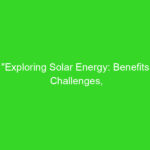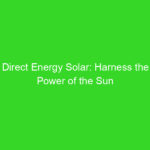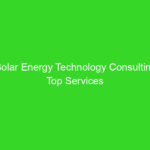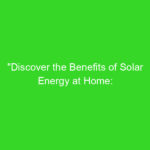
Disadvantages of Passive Solar Energy
Passive solar energy is a technique of using the sun's energy to heat and cool buildings without any mechanical or electrical systems. It is a cost-effective and environmentally friendly method of utilizing solar energy. Passive solar energy systems are designed in such a way that they can capture, store, and distribute solar energy for heating, cooling, and lighting buildings. However, despite the numerous benefits of passive solar energy, it has several disadvantages which need to be considered before investing in the technology.
In this article, we will discuss the disadvantages of passive solar energy and why it might not be the best option for everyone.
1. Climate and Location Restrictions
Passive solar energy systems are heavily dependent on climate and location. The effectiveness of passive solar energy systems depends on the amount of sunlight received by a particular location. Therefore, areas with less sunlight may not be able to generate enough energy to meet their heating and cooling requirements. Similarly, areas with high temperatures may not be suitable for passive solar energy systems as they can overheat the building.
2. Initial Cost
The initial cost of installing passive solar energy systems can be quite high. The installation of a passive solar energy system requires specialized design and construction techniques. These techniques are generally more expensive than traditional building techniques. The cost of installing a passive solar energy system varies depending on the size, location, and complexity of the system.
3. Maintenance and Repairs
Passive solar energy systems require regular maintenance to ensure that they are working efficiently. The components of the system, such as the glazing and insulation, require periodic cleaning and replacement. Any damage to the system can also affect its efficiency, and repairs can be expensive.
4. Design Constraints
Passive solar energy systems require a specific design to work effectively. The building's orientation, window placement, and shading must be carefully considered during the design process. These design constraints may limit the building's aesthetics or functionality.
5. Energy Storage
Passive solar energy systems do not have energy storage capabilities. This means that energy generated during the day cannot be stored for use at a later time. Therefore, energy generated by passive solar energy systems can only be used during the day. This limitation makes it difficult to rely entirely on passive solar energy systems for heating and cooling.
6. Lack of Control
Passive solar energy systems rely on natural processes to provide heating and cooling. This means that there is limited control over the temperature and lighting conditions in the building. This lack of control can be frustrating for some people who prefer to have more control over their indoor environment.
In conclusion, passive solar energy is an environmentally friendly and cost-effective method of utilizing solar energy. However, it has several disadvantages that need to be considered before investing in the technology. These disadvantages include climate and location restrictions, initial cost, maintenance and repairs, design constraints, energy storage, and lack of control over temperature and lighting conditions. Therefore, before investing in a passive solar energy system, it is essential to evaluate whether it is the right option for your building and location.





